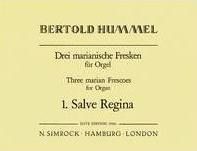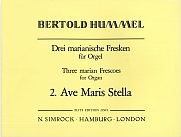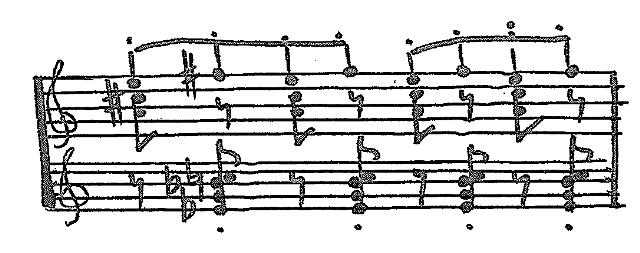Three Marian Frescos for organ op. 42 (1970/1971)
 |
 |
 |
I. Salve
Regina ![]() beginning
beginning
II.
Ave Maris Stella ![]() beginning
beginning
III.
Regina Coeli ![]() beginning
beginning
First
Performance: December 20, 1970, Freiburg, Münster
Hans
Musch
American
Premiere: December 8, 1976, Washington, National
Shrine of the Immaculate Conception
Günther
Kaunzinger
Duration: 15 Minutes
Publisher: N. Simrock Hamburg-London
(Boosey & Hawkes)
op.42
Nr.1 Salve Regina ISMN M-2211-0850-0
op.42 Nr.2 Ave maris stella ISMN M-2211-0851-7
op.42 Nr.3 Regina coeli ISMN M-2211-0852-4
| I. Salve Regina | II. Ave Maris Stella | III. Regina Coeli |
Errata:
Starting point
are the three Marian antiphons Salve Regina - Ave
Maris Stella - Regina Coeli.
The form of the work is in three movements, fast - slow
- fast, and the approach symphonic. The basic material,
taken in each case from the Gregorian model, is present
at all times in the course of the corresponding
movement.
Most of the
time, the principle of melodic construction is a
re-formulation of the initial material within a field of
polytonal tension.

The material of the chords is mostly derived from the original melodic structures.

Salve Regina: Following its appearance, an idea gains in profundity as it is lead along the most varied paths in a quasi development. The natural, almost mechanical, flow is repeatedly interrupted by adagio insertions, which provide formal subdivisions. In the coda, the main ideas are summarised once again.
Ave Maris Stella: From a unisono start (with echo effect), a variations form develops, in which the individual sections are joined together by something like bridge passages. The sections are ordered in an arch. A basically contemplative mood prevails.
Regina
Coeli: Over diatonic starting material,
which dominates the entire movement, polytonal columns
of chords are erected. Ostinato figures maintain the
flow. At the centre of the movement, distinguished also
by its own tempo, the principle idea is presented in
contrapuntal treatment.
As a kind of accompanying contrast, a chromatically
coloured flourish is set against the diatonic "theme".
These two elements interpenetrate each other
increasingly in the course of the movement and are
finally fused together into a unity.
Bertold Hummel
Larry D. Crummer: The Solo Organ Works by Bertold Hummel, Dissertation 1983
Press
fono forum,
June, 1978
Hummel's "Marian Frescos" are captivating from the first bar, in which the Salve Regina resounds like a fanfare. Hummel's work with the organ and the Gregorian material of the three Marian antiphons of the Roman liturgy is sovereign, allowing quotations to shine out, concealing thematic references in the frequent accompanying parts, presenting a quasi cantus firmus or using it as a powerful introduction to the chant melody - as in Regina Coeli, in which columns of chord construction tower above the beginning pedal solo. Two movements in solemn motion, exploding in chords, frame the more peaceful, quieter Ave Maris Stella - all three movements are full of tension, dynamic energy and expression.
Mittelbayerische
Zeitung Regensburg, 5th November, 1971
In the closing Triptych by Bertold Hummel, the significant word in the title seems to me to be above all "Frescos", namely frescos which realise in sound what the contemporary artist might conceive in the form of frescos for a church interior: large-scale sound impressions in powerful colours between which restrained and graded colours appear. The theme of each fresco recurs time and again, either in original form or modified through adaptation to the surrounding colours - not really as a formally shaped sequence of representative elements, although powerful lines impose themselves on the whole field of each fresco and are guided in this by a certain improvisatory hand. Seen from the organ, these are great improvisations fixed in written form, pieces in which the musical demands made are thoroughly suitable for the instrument, breathing the spirit, structure and content of the three Gregorian melodies.
Rottenburger
Post, 12th November, 1976
All three of these Frescos live from contrast, for example between rapid solo figures, thrown in in arpeggio-like form, and dissonant, thrusting chords, which are in turn replaced by almost lyrical elements. They may enclose as thematic material the Gregorian Salve regina, or may work with echo-like effects originating in a melody constructed out of a tritone, or may result from bitonal techniques, that is, from the simultaneous combining of different diatonic keys (see Regina coeli). It is thus a work offering ample opportunity, as French organ compositions do, to show brilliance in shaping and to employ surprising registration effects.
Musica
Sacra, March/April, 1981
Hummel's Marian Frescos are already ten years old, but they have lost none of their Gregorian-based freshness. Essential music of the contemporary organ scene.
Mainzer
Allgemeine Zeitung, 5th February, 1987
Joseph Bonnet offered as a continuation from Reger, after a pause for reflection, "Regina Coeli" from "Three Marian Frescos for Organ" by Bertold Hummel (born 1925). This composer sets before us successive waves of towering sounds, with dissonances which seem to dissolve in space. Strange glass-clear bell sounds appear above held notes; torn, boldly wild climaxes, storm-like aggression, lead into an almost surprising calm in the best tradition of major tonality.
